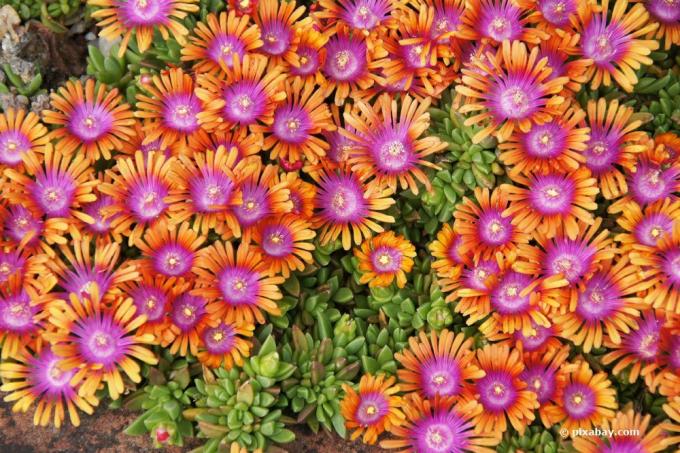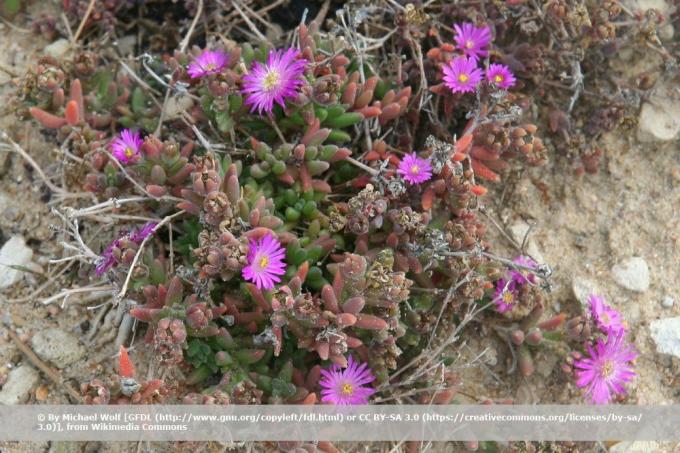
table of contents
- Hardy midday flowers
- General information on winter hardiness
- Species of ice plant known as hardy
- wintering
- Requirements for successful wintering
- This is how the ice plant can be hibernated over the winter
- What to do with Delosperma varieties that are not hardy?
Originally the different types of ice plant, which is derived from the Greek Delosperma, come from the African region. Since it is now also used in our garden design, the question, which is justified in our part of the world, is whether the ice plant should be hibernated over the winter. Although not actually exposed to frost in their homeland, the popular ornamental plants can be brought through the winter in Germany with a few tricks.
Hardy midday flowers
Even if they all belong to the ice plant family, the individual Delosperma species differ in terms of their winter hardiness. Some species are explicitly known as hardy, while other species, or even ignorance of the exact species in their own garden, quickly lead to uncertainties among hobby gardeners.
General information on winter hardiness
Regardless of the exact species, a few characteristics can be used to reliably estimate whether the ice plant in question is hardy or whether it requires increased effort for wintering.
The most obvious sign of a certain winter hardiness is a stocky growth. More compact types of ice plant are less sensitive to frost than types with a tall inflorescence. The formation of clumps in the plant body is also an indication of a higher degree of frost resistance compared to midday flowers without pronounced plant clusters. A more compact form of the plant avoids particularly finely developed and therefore frost-prone components.
Species of ice plant known as hardy
These midday flowers, which are widespread in our country, are considered hardy and are therefore particularly suitable for outdoor use:
- Delosperma Red Fire
- Delosperma Indian Summer
- Delosperma Fire Spinner
- Delosperma African Queen
- Delosperma Golden Nugget

wintering
Requirements for successful wintering
In order to bring the midday flowers in your own garden undamaged through the winter, an understanding of the problems of wintering is one of the essential basic requirements. Contrary to popular belief, it is not the actual cold that is the critical factor with regard to the winter hardiness of the ice plant. Instead, two aspects can be clearly identified that only become a serious problem in connection with the winter cold.
- Moisture: The ice plant prefers full sun and rather dry locations. From her home country she knows and loves sandy soils without waterlogging. If you compare our rather heavy soils and the high amounts of precipitation in winter, it quickly becomes clear that the conditions here are not ideal. Excessive soil moisture is a problem, especially in winter. On the one hand, wet soil dries very slowly in winter, so that the water that is present can easily rot in the root areas and thus cause the plant to die. The second disadvantage of the high soil moisture is the damaging effect on the finest root segments when the water in the soil freezes through during periods of frost and expands considerably in the soil.
- Bald frost: Winter temperatures are always no problem when a protective blanket of snow protects the soil and plants from excessive frost. If this insulation is missing, however, hard frost will reach the plant undiminished and can lead to considerable damage there. One speaks of clear frost, because the frost reaches the bare, not snow-covered ground. The winters with little snow and short periods of extreme cold, which have increased in recent years, are particularly unfavorable for the ice plant to overwinter.
This is how the ice plant can be hibernated over the winter
In the case of hardy or at least partially hardy Delosperma species, effective protection of the plant over the winter time can be achieved with just a few measures. Even unfavorable winter conditions as well as extreme weather events can be mastered this way.
- Creation of a drainable soil by adding gravel / sand to increase the water runoff
- Covering the planted areas to reduce rain moisture
- Replacement of a missing, frost-protecting snow cover with brushwood, coconut mats, or similar materials

What to do with Delosperma varieties that are not hardy?
If, on the other hand, your own Delosperma is not hardy, the only option for safe wintering is to keep it in a plant pot. In the pot, it should then survive the winter in a frost-protected, but unheated room with sufficient daylight. Temperatures above 5 ° C should be avoided, as otherwise the plant will interrupt its winter dormancy and begin to form new shoots.
Tip: Also not or only partially hardy midday flowers can survive the cold season. Since the Delosperma species reproduce by self-sowing in the same location, it occurs after the mother plant dies in winter often a new seedling from the seeds already present in the soil, which revitalizes the location of the old plant with the approach of spring.



